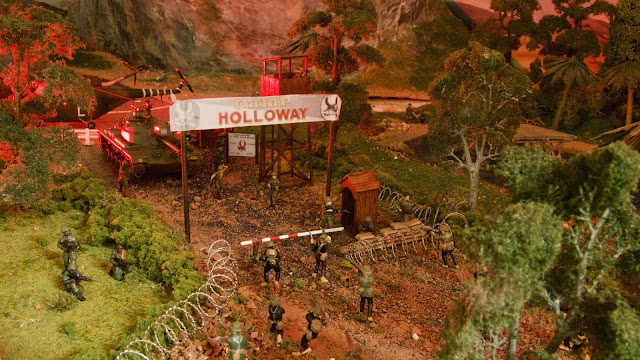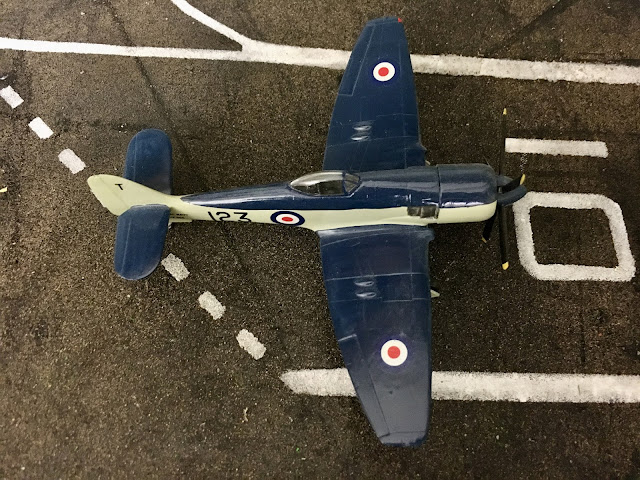Hobart's funnies of the 1944 D-Day landings were my last tank builds and had it not been for me discovering the delights of the Operation Silver Bayonet multi kit it would not have been a tank I'd be sharing with you now but my next helicopter build .. as it is, this will now have to wait.
 |
| Italeri 1/72 scale M48 A2/A3 Patton |
The tank which the US sent to fight the sandal wearing, bicycle pedalling North Vietnamese was the M48 A2/A3 Patton and Italeri included this in their multi kit. The initial M48s first landed with the US Marine 1st and 3rd Tank Battalions in 1965 and although 600 were eventually sent to Vietnam, there were few actual tank versus tank battles. Most M48s were either used for static gun support to infantry or simply as a deterrent.
The M48 Patton was an American first generation 'main battle tank' introduced in February 1952 to replace the M26 Pershing, M4 Sherman and M46 Pattons which had been used in the Korean War. While its role in Vietnam may have been underwhelming, the M48 did see heavy action in the Indo-Pakistani Wars against India's Soviet supplied T55s, and during the Six-Day War of 1967 in the hands of the Israelis against Egypt's Soviet supplied T-54s/T-55s, T-34/85s. It was also the tank which faced off against Soviet T-55 tanks across Checkpoint Charlie in the The Berlin Crisis of 4 June to 9 November 1961. This crisis was brought about followed the USSR's ultimatum to the West, to the withdraw all armed forces from West Berlin which concluded with the the Soviet / East German construction of the Berlin Wall.
 |
| U.S. M48 tanks face Soviet T-55 tanks at Checkpoint Charlie, October 1961. |
My experience in constructing the M48 scale model was probably one of my worst in recent history. I removed 10 wheels from their sprue by cutting off the lugs which attached them to the body and so had to individually glue them all back on. See the picture below of the actual tank running gear. It was these 'lugs' visible to the left of the wheels which Italeri had decided to use rather than traditional axle fixings! Then when attaching the railings around the turret, I managed to let glue flow into rotating mechanism such that it seized in the forward facing position ... fortunately a tank on sentry duty does not have to move! (see later comment). On a positive note, because the full sized turret and hull were made of huge castings rather than welded pieces - making the it immensely strong - it was harder to craft into a smooth shape, something which Italeri replicate in their scale model very well and a factoid which changed my opinion of Italeri turning out a poor quality lumpy build to a 'thumbs up' to Italeri for creating a realistic scale model! Despite all the issues, the end result is OK when viewed from a distance!
 |
| How the running gear look on the real thing |
Meanwhile, I was lucky enough this week to drop in at the Bovington Tank Museum to get a close up view of their M48. This, as pictured below, is an early model - labelled as the T48, its project name before receiving its production 'M' nomenclature - that was sent to Britain for testing and examination.
 |
| Bovingtin Tank Museum's T48 / M48 |
The only reference to tanks being used in the 1965 Battle of Ia Drang and thus Operation Silver Bayonet, is when a South Vietnamese relief force, which included tanks and armoured cars, was not only delayed gathering troops but was also halted almost immediately at a bridge destroyed by local Viet Cong! I did not feel justified, therefore, even with the generous use of poetic license I've already used, to include the M48 in my diorama of the attack on the North Vietnamese supply base in the Drang Valley, instead I placed it on sentry duty, guarding the helicopter airbase of Camp Holloway, reminding me somewhat of that Chieftain tank that sits outside the MOD Defence Storage and Distribution Agency (DSDA) off the A46 in Ashchurch.
 |
| M48 provides support and cover to soldiers repelling the NVA attackers |
So, in my Vietnam War diorama, picture the scene: North Vietnamese & Viet Cong soldiers launch a morning raid on 7th February, 1965, at Camp Holloway airbase 3km east of Pleiku in the Central Highlands, causing over 100 US casualties and destroying 18 helicopters. The blazing wrecks of the Hueys illuminate the dawn sky and the heat and the acrid smoke from the fires fill the air across the base. The M48 on sentry duty, using its .5 caliber machine-gun and 90mm main gun, provides support and cover for the soldiers engaging the communist attackers. It is following this attack that U.S. President Lyndon B. Johnson is so instanced that he orders the bombing of North Vietnam, plunging the county into a bitter war of attrition which will last the next 10 years.
 |
| More shots from Camp Holloway |
There were actually just 3 true tank versus tank battles of note, where US or later, South Vietnamese, M48s took on Soviet built T-34, T-55 and PT-76 tanks of the NVA. The first was really a minor skirmish when US tanks fought off an NVA attack on Ben Het Camp, similar but more successfully dealt with than the Camp Holloway incident, in March 1969, destroying 2 PT-76 amphibious light tanks. The second, in February 1971, involved 62 South Vietnamese tanks in the disastrous Operation Lam Son 719 which catastrophically failed in its attempt to disrupt the Ho Chi Minh Trail along which the NVA brought resources south and across the border from Laos. The final engagement, in more ways than one, was during the 1975 Spring Offensive. With the US forces having all but pulled out of Vietnam by 1973, having agreed a 'convenient' cessation of hostilities with the North, this was effectively a final fight to the end between the North & South. The NVA drove the South Vietnamese, now lacking both US air and financial support, out of the Central Highlands, where the fighting began 10 years ago, and into the final battle in which with only 89 tanks the NVA captured Saigon and its defending 550 tanks!
---
The model
Brand: Italeri
Title: M48 A2/A3 Patton
Number: 7015
Scale: 1:72
Type: Full kit
Released: 2003 | Rebox (Updated/New parts)



































